Load cell, weighing electronics, industrial scales from Minebea Intec
- Details
- Hits: 17217
The load cell is small, inconspicuous and yet indispensable in many industries: installed in industrial scales, e.g. For example, in numerous areas of industry such as goods receiving and shipping, it ensures that the contents or filling levels of containers, tanks and silos as well as vehicles are precisely determined. Read about the innovations MinebeaMitsumi Daughter Minebea Intec in the field of load cells, weighing electronics, weighing modules and industrial scales for industrial weighing.

Contents
- Combination checkweigher for weighing and metal detection
- Checkweighers for industry at Interpack
- Industrial scale for efficient weighing in candy factory
- Load cell in the global Covid-19 vaccine production
- Digital weighing modules for silo weighing
- Hygienic weighing module with new load levels
- Digital or analog in industrial weighing with load cells
- Load cells and weighing electronics for industrial weighing
- What is a load cell and what types are there?
Combination checkweigher for weighing and metal detection
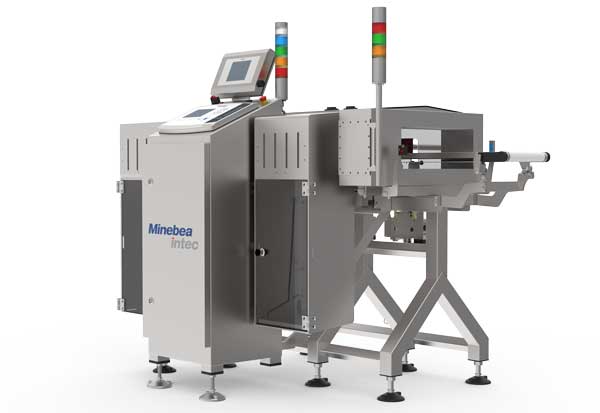 Sep 30.09.2023, XNUMX | The new checkweigher Essentus Performance L Combi from Minebea Intec combines the Essentus Performance L checkweigher with the Vistus metal detector in one base frame. Two control units (HMI) share weighing and metal detection. The combination can be used to check weights, carry out completeness checks, control upstream filling systems and check a product for foreign bodies. The industrial scale is extremely space-saving, calibratable and optionally offers a weighing table made of stainless steel for the highest hygienic requirements.
Sep 30.09.2023, XNUMX | The new checkweigher Essentus Performance L Combi from Minebea Intec combines the Essentus Performance L checkweigher with the Vistus metal detector in one base frame. Two control units (HMI) share weighing and metal detection. The combination can be used to check weights, carry out completeness checks, control upstream filling systems and check a product for foreign bodies. The industrial scale is extremely space-saving, calibratable and optionally offers a weighing table made of stainless steel for the highest hygienic requirements.
Precise weighing
With Strain gauges-Technology (DMS) of the latest generation, products are precisely weighed and checked for completeness. A possible control of upstream filling systems and various statistics that meet all requirements for production monitoring and data evaluation in accordance with the prepackaged packaging regulations can be set up. The detailed evaluations are visible at a glance on the control unit. Thanks to automatic speed adjustment, the easy-to-use scale can be integrated into existing production lines.
Various Conveyor belt lengths are available to choose from. With the L version, light products up to 6 kg can be weighed optimally. The H version weighs heavy products up to 60 kg. A cheaper version is also available with basic functions for weighing.
Reliable metal detection
The Vistus metal detector achieves optimal detection sensitivity under all operating conditions. Even small metal particles such as high-alloy steels and non-ferrous metals (copper, brass, aluminum, lead, etc.) can be detected in products. High-quality components and a wide frequency spectrum are used for maximum detection performance and reliability. Dialogues tailored to different user groups ensure maximum user-friendliness. A variety of variants and dimensions cover many individual requirements.
The combination checkweigher is in protection class IP54 and can optionally be purchased in IP65 for hygienic requirements, especially for wet applications or unpackaged products.
Checkweighers for industry at Interpack
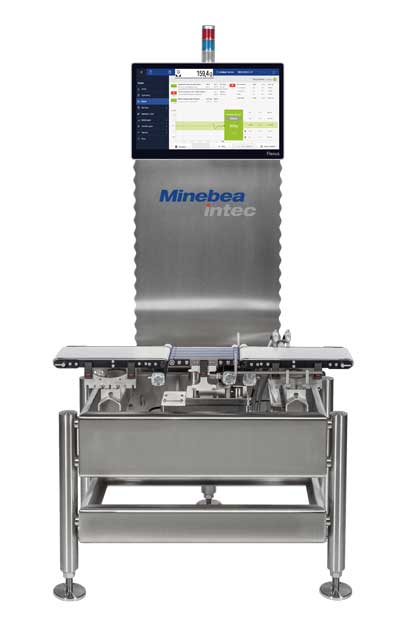 04.05.2023 | Minebea Intec presents at the Interpack 2023 including a newly developed user interface for dynamic checkweighers and a combined industrial scale.
04.05.2023 | Minebea Intec presents at the Interpack 2023 including a newly developed user interface for dynamic checkweighers and a combined industrial scale.
The new user interface for dynamic industrial scales in the control allows intuitive operation and is therefore very user-friendly. With the interface, the industrial scales can be easily configured, controlled, tested and audited. Whether the user teaches in a new article, adjusts line parameters or defines a batch report:
With the interface of this scale, work becomes more efficient. The control unit of the industrial scale displays the Overall Equipment Efficiency (OEE) and other statistics that result from the current weighing results. The scale has various protocol functions for audits. The interface is MID-certified with weighing technology.
Also on display at the fair will be the dynamic control scalee Essentus Performance L Combi in a new design. The advanced scale is a combination of the metal detector Vistus in a base frame and the check scale Essentus Performance L as a basis. Thanks to the integration of the metal detector, the industrial scale is very efficient with a size that is extremely space-saving.
The combination scale checks weights, carries out checks for completeness and controls upstream filling systems. At the same time, the scales check the goods to be checked metallic foreign bodies. The Essentus Performance L Combi scale is designed for calibration. The conveyor system is made of stainless steel, which means that the scale can also be used in hygienic applications, especially for wet applications or unpackaged products.
Industrial scale for efficient weighing in candy factory
 December 07.12.2020, 732 | This year, according to forecasts, sales of confectionery worldwide will amount to around XNUMX million euros. Because global confectionery consumption is constantly growing, manufacturers of chocolate etc. have to make their production facilities competitive. With a state-of-the-art Industrial scale and Inspection solution efficiency can be increased in the confectionery industry.
December 07.12.2020, 732 | This year, according to forecasts, sales of confectionery worldwide will amount to around XNUMX million euros. Because global confectionery consumption is constantly growing, manufacturers of chocolate etc. have to make their production facilities competitive. With a state-of-the-art Industrial scale and Inspection solution efficiency can be increased in the confectionery industry.
Load cell in the global Covid-19 vaccine production

27.05.2020/XNUMX/XNUMX | The global economy has been at a standstill since the outbreak of the Coronavirus Head. Once solid structures such as import, export and delivery are proving to be fragile constructs in times of pandemic. But while many companies in the manufacturing industry worldwide have to cope with deep cuts, individual manufacturers are demonstrating top performance where it matters most in such times. As the load cell This article shows, among other things, helps in vaccine production.
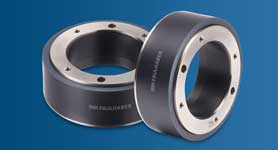 stepper motor | Precise low cost positioning
stepper motor | Precise low cost positioning
In these weeks there is great hope in vaccine production in the pharmaceutical and biotech industries. The world is waiting for the final solution of the Covid-19 pandemic. The vaccination of the entire population promises the long-awaited turning point towards a return to normalcy.
Corporations around the world are working flat out to develop and produce reliable vaccines. Suppliers such as Minebea Intec, global manufacturer of industrial scales, weighing and inspection technologies, supports them with special technologies. Plants and systems weigh mixing containers, control packaging steps under the strictest hygienic requirements and enable standardized, precise processes on the production lines. How this can be done in practice is illustrated by the use of a load cell at the biotech company Cansino.
Load cell in vaccine production at Cansino
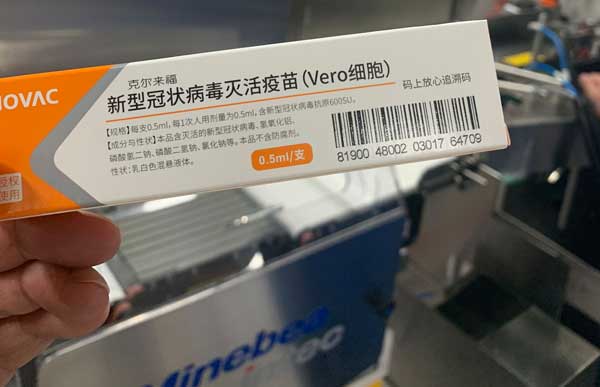 Tired China is developing a vaccine against the Covid-19 virus with the military's medical department. The load cells and weighing technology help the researchers do this. In the manufacturing process, the load cell ensures high-precision weighing and dosing.
Tired China is developing a vaccine against the Covid-19 virus with the military's medical department. The load cells and weighing technology help the researchers do this. In the manufacturing process, the load cell ensures high-precision weighing and dosing.
When developing a vaccine against Ebola in 2014, Cansino relied on the quality of the load cells from Minebea Intec. Tianjin-based Cansino is one of 41 providers worldwide working on a vaccine against the virus. The company was one of the first to start developing a vaccine against Covid-19.
In the first half of 2020, the Chinese government granted permission to conduct a clinical study with the Tests on people to start. Minebea's weighing technology and load cells previously ensured reliable weight determination, precise dosing and fast transmission of measurement data when the first substances were manufactured.
Many customers of pharmaceutical and biochemical applications appreciate the precise weighing with the load cell to determine the weight of Minebea. Cansino sets the Scales There are three main stages in the manufacture of the vaccine. Using the virus-vector vaccine technology based on the adenovirus, the RNA fragments of the Covid-19 virus were inserted into the adenovirus. So a recombinant protein vaccine was created. This combination is placed in a bioreactor. There are three compact PR 6212 load cells under the reactor.
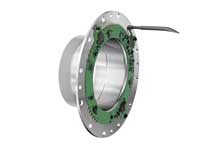 Measuring torque with sensors inside the transmission
Measuring torque with sensors inside the transmission
In this bioreactor, the combinations are scaled up and cleaned under precisely controlled conditions. That forms the basis for the vaccine. The PR6212 load cell serves here to measure the weight in real time. If necessary, the load cell can be adapted quickly. The highly accurate results of the load cell have an error class of only 0,04%. This is all the more astonishing because the bioreactor is constantly stirring the materials and so precisely Measurements the load cells difficult. The load cells are connected to an IP69 CablesConnection box PR 6130 / 65S connected, which is extremely resistant to external forces. The data transmitter PR 5211/10 transmits the data from the load cell to the computer.
Vaccine test on humans
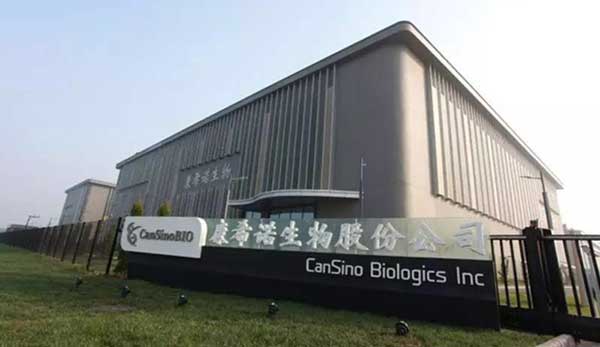 After the Scale-up process In the bioreactor, the resulting product is cleaned of all undesirable substances. However, the now pure product cannot be tested directly on humans in this form. It must be supplemented with additives such as stabilizers and adjuvants.
After the Scale-up process In the bioreactor, the resulting product is cleaned of all undesirable substances. However, the now pure product cannot be tested directly on humans in this form. It must be supplemented with additives such as stabilizers and adjuvants.
The mobile used here IF floor scales offers a very high level of accuracy with a weighing resolution of up to 30.000 d. Thanks to their high-quality materials, the scales further facilitate the process. The cleaned raw material is now placed in a container on the floor scale and the additional ingredients are added using the manual recipe function of the scale.
After a further test phase in the laboratory, the clinical testing of the substance as the last phase. "The process of finding a vaccine against corona is currently one of the most important tasks worldwide. Results are needed as soon as possible, without compromising quality or safety," emphasizes Wangjiang, Managing Director of Minebea Intec China. "Our load cells and weighing products play a crucial role in delivering optimal accuracy and weighing results in real time."
For the Ad5-nCoV vaccine Cansino relies on an adenovirus-based viral vector platform that was also used for the Ebola vaccine. This vaccine has already been successfully tested on animals.
The vaccine safety was reviewed and the substance's ability to induce immunity against the virus was assessed. In the first human trials phase, healthy people become between the ages of 18 and 60 tested in Wuhan. 108 participants are divided into three groups that receive different doses of the vaccine. A safe vaccine, the effectiveness and the level of antibodies are measured.
"We are honored to have Cansino after using our weighing equipment for the Ebola vaccine puts their trust in our items once again," emphasizes Wang Jian. "Although it is only a small contribution, we are glad that our solutions help in applications such as the fight against Corona."
Highly precise processes, maximum discretion, fast supply
 The production details are of course a trade secret. “Our technologies are little known outside of the industry,” explains Willy Sebastian Metzger, Director Marketing, Strategy and Business Development at Minebea Intec. “Information about which machines ensure the quality of the production processes gives unwanted insights. Our customers therefore usually insist on secrecy ”.
The production details are of course a trade secret. “Our technologies are little known outside of the industry,” explains Willy Sebastian Metzger, Director Marketing, Strategy and Business Development at Minebea Intec. “Information about which machines ensure the quality of the production processes gives unwanted insights. Our customers therefore usually insist on secrecy ”.
In the current Corona reporting, Minebea Intec technologies appear on the surface at best as extras. Highly accurate measurement results play a key role here. “Our facilities and systems are integrated into the key production lines of American vaccine producers. In China even in all three production facilities, including that of the Coronavac manufacturer Nephew Biotech”, Reports Mr. Metzger.
Highly precise, reproducible processes are an essential component in vaccine development and production. The company offers research and production departments special technologies and hygienic designs. Of course they correspond worldwide standards. For example, load cells are installed under bioreactors and connected to evaluation electronics so that the perfect mixing ratio of raw vaccine and other substances is ensured. Other dynamic weighing solutions ensure the exact filling quantity of the vaccination doses.
Customers in the pharmaceutical and biotech industries are currently generating a high volume of orders for the weighing specialist. “We are proud to contribute to the Fight the pandemic and we work with the utmost commitment to deliver orders in the best possible way. We have managed to do this very well so far, ”says Willy-Sebastian Metzger, underlining the commitment of his company.
More and more systems from the manufacturer are also found at manufacturers of Corona rapid tests Application. However, industrial weighing and inspection technologies also secure the manufacturing processes of many other industries. Wherever production is automated, measuring points are integrated into the ongoing process: in conveyor belts, process containers or using overarching software. The interaction of scales, sensors, metal detectors and systems for X-ray inspection ensures consistently high quality for the consumer.
Digital weighing modules for silo weighing
 19.11.2019 | Minebea Intec presents the established load cell Inteco with a digital upgrade, the "Novego" weighing module with the highest measuring accuracy and a successful cooperation from the service area with the new LC load cells and CSD weighing electronics.
19.11.2019 | Minebea Intec presents the established load cell Inteco with a digital upgrade, the "Novego" weighing module with the highest measuring accuracy and a successful cooperation from the service area with the new LC load cells and CSD weighing electronics.
The Inteco load cell was developed with the Converter Connexx equipped and can be easily and economically installed without a cable junction box. The load cell offers customers from various industries a significantly expanded range of options - from simple filling quantity control to high-precision weighing of the heaviest silos and containers.
Trade fair visitors can also see the result of a cooperation between Minebea Intec and the Tokyo-based parent company Minebea Mitsumi: The LC load cells and the new weighing electronics of the CSD series. With the LC Solo and CSD series, the manufacturer combines products that it has designed and developed itself with products that are tailored to the individual needs of the customer.
In future, the series will also incorporate larger themes such as the Internet of Things or large amounts of data.
Hygienic weighing module with new load levels
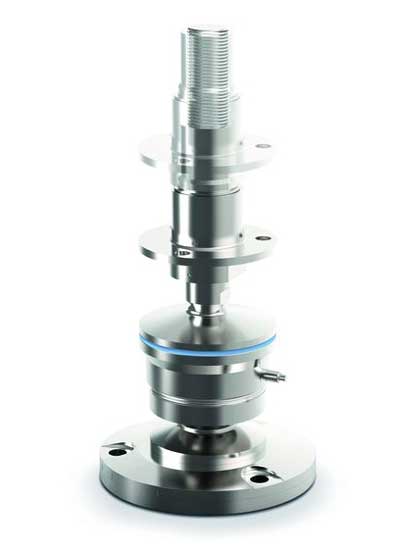 03.09.2019 | The weighing module Novego by Minebea Intec was specially developed for the high demands in the food industry. The hygienic all-in-one solution is easy to install, reliable and offers reliably precise measurement results in weighing processes even with lateral forces of up to 20% of the nominal load.
03.09.2019 | The weighing module Novego by Minebea Intec was specially developed for the high demands in the food industry. The hygienic all-in-one solution is easy to install, reliable and offers reliably precise measurement results in weighing processes even with lateral forces of up to 20% of the nominal load.
When weighing goods cause so-called Lateral forces a measurement uncertainty that is undesirable for weighing processes. These forces arise z. B. when switching on rotating mixing devices and can falsify the weighing result. This has a negative impact on the economics of processes, especially when the quantities delivered or received are cost-intensive.
With Novego there is a solution to these requirements, which is now down to two additional load levels has been expanded. A special design made the modules insensitive to such influences. Several high-precision strain gauges ensure the high C3 measurement accuracy in accordance with the R60 guidelines of the international organization for legal metrology OIML.
In addition to the high measurement accuracy, users benefit from a modular system. A variety of feet and adapters with well thought-out details ensure easy and safe installation, even in existing systems. In addition, the usual installation kits and restraints against acting forces can be omitted.
The weigh modules feature an integrated installation kit with a 360° restraint that eliminates the need for time-consuming handlebar alignments, an anti-lift device, and an anti-tilt device. Novego is also designed in such a way that containers can be returned to their original position after they have been deflected.
The Hygienic Design ensures efficient cleaning processes, for example through minimized horizontal surfaces, which ensure that liquids can easily drain away and thus dry faster. Through the use of FDA-compliant silicone and the extremely corrosion-resistant 1.4418 stainless steel with low surface roughness, which is new in weighing technology, the weighing modules meet the strict requirements of the food industry.
Digital or analogue in weighing with load cells
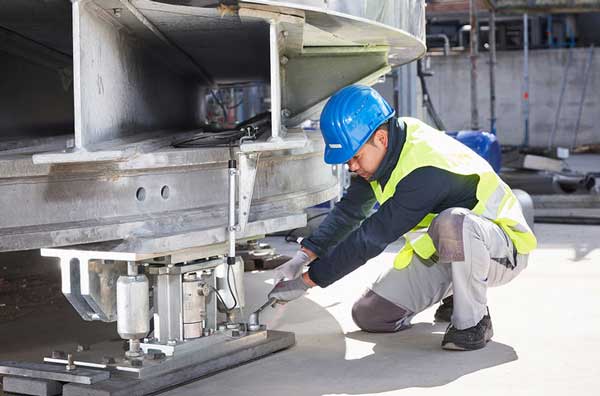
24.06.2019/XNUMX/XNUMX | Analogue and digital Load cells provide the technical basis for precise processes in a wide variety of industrial sectors weighing and dosing of goods and for their billing. Digital systems have many advantages for the user. Minebea Intec is a specialist here, offers digital and analogue load cells and knows when which should be used.
Load cells often serve as the basis for billing quantities and provide precise and reliable measured values. Load cells do not require regular maintenance or recalibration and are extremely robust and durable. The majority of the load cells currently in use are still based on analog technology, but digitization has also been finding its way into weighing processes for some time. A Generational change brings clear advantages for the user during the installation.
This is how the signal transmission in digital weighing solutions takes place via fieldbussystems, eliminating the need for cable junction boxes or external power supplies as opposed to analog load cells. In addition, with such fieldbus solutions, considerably longer cable distances between the load cell and indicator as well as the direct connection to system components such as PCs or programmable logic controllers in the process can be implemented.
Weighing systems are also becoming safer and more reliable through the use of digital solutions: Defective load cells can be easily identified and, if necessary, replaced immediately, since the measured weight values are available individually for each load cell. This is where the transparency of digital systems pays off: Existing measured values are available at any time at practically any point in the process. The new digital solutions also enable reliable and precise dosing processes thanks to their fast signal propagation times.
Further development of a classic
With the analog Compression load cell PR 6201 introduces Minebea Intec A reliable, highly accurate system for weighing loads between 500 kg and 520 t has been available to users for decades. “This product can confidently be described as a classic in load cell technology,” says Holger Nichelmann, Global Product Manager of the company. "Anyone dealing with the subject of weighing knows this product or has already used it."
According to the motto "Make the tried and tested better", the company recently presented a further development of the PR 6201 load cell, which offers additional advantages in many details in the application and is available in analog and digital versions. The new analogue load cell "Inteco" provides an output signal of 2 mV/V. This doubling of signal strength Compared to the PR 6201, the possibility of evaluation in the subsequent weighing electronics is significantly improved and thus leads to a more precise presentation of the measurement results.
“The Inteco is suitable for high-precision and calibratable tasks. With the new load cell, we were able to achieve OIML C6 approval for almost all load levels, which shows the potential of this further development," explains Nichelmann. "For applications in which an exact determination of the weight of the materials is essential for the process result, Inteco represents the optimal solution."
There is also Inteco with two additional load levels of 60 and 75 t per load cell. Both the measuring element and the housing of the Inteco load cell have been upgraded through the use of stainless steel, which, according to Nichelmann, leads to increased corrosion resistance and thus a longer service life, especially in applications with aggressive gases or cleaning agents. An important feature of the Inteco for users is that its mechanical dimensions correspond exactly to those of the PR 6201, making it easy to convert to the new generation without changing installation kits or fixed bearings.
Digital variants for particularly long distances
The manufacturer has the advantages of digital technology for weighing systems with the Converter Connexx implemented intelligently. "Connexx is an A/D converter that is permanently connected to an Inteco load cell and converts its output signals directly into digital values, which are then available for further processes via the standard CAN open fieldbus," Nichelmann describes the digital version.
According to the product manager, this constellation allows particularly long distances between the load cell and the indicator, which is essential for some applications. Also a problem-free conversion of the CAN openstandard protocol to other protocols with conventional solutions is possible.” Due to its IP68 protection class, the Connexx converter guarantees reliable operation in water depths of up to 100 m for up to 1,5 hours. The load cell can even withstand use in this water depth for up to 10.000 hours .
 Edge computing software efficiently increases productivity
Edge computing software efficiently increases productivity
The digital compression load cells of the Pendeo Processseries available. The products of the "Pendeo Truck" series are adapted to the requirements of vehicle weighing. Their design principle, in conjunction with suitable installation kits, enables movements in the bridge construction to be compensated.
Matched offer digital or analog
Simply measuring weights is usually not enough: “It is extremely important for the user to be provided with a helpful evaluation of the measured data,” emphasizes Mr. Nichelmann. For this purpose, Minebea Intec offers a wide selection of weighing electronics for all requirements, from simple transmitters or indicators to complex weighing controllers. With the help of Digital assistance technology (DAT) users can put their weighing solutions into operation more quickly, monitor them seamlessly and maintain them efficiently.
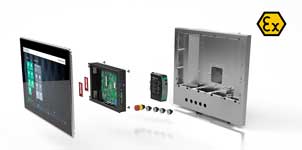 HMI platform for industrial operation and monitoring
HMI platform for industrial operation and monitoring
With all the advantages of digital weighing - when do manufacturers opt for analogue load cells? "Not every application fully benefits from the benefits of digital load cells, so it must be decided on a case-by-case basis which solution is more economical. Of course, what matters is the overall result, "explains Holger Nichelmann. "This is where our many years of know-how can help. For questions like these we offer our customers our in-house engineering support. "
From analogue and digital load cells to matched ones installation kits and the necessary accessories through to powerful weighing electronics, users will find all the necessary and perfectly coordinated components for the precise weighing of a wide variety of container types and silo types as well as vehicles of various sizes and industries.
This also includes systems for weighing containers and silos in high-load and hazardous areas, as well as hygienic solutions for use in the food, beverage and pharmaceutical industries.
Load cells and weighing electronics for industrial weighing
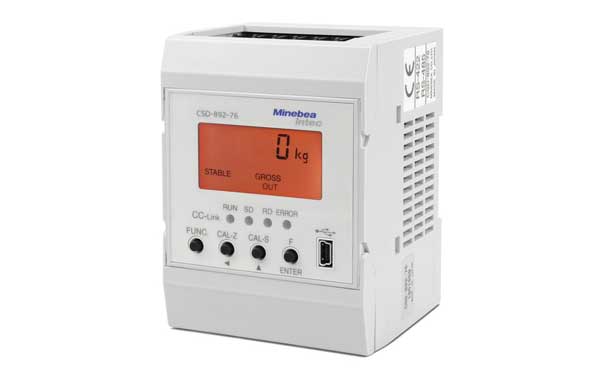 17.05.2019/XNUMX/XNUMX | With two product series, Minebea Intec is expanding its range to include components for reliable industrial weighing.
17.05.2019/XNUMX/XNUMX | With two product series, Minebea Intec is expanding its range to include components for reliable industrial weighing.
The LC series load cells offers reliable weighing solutions for the construction of bench scales, counting scales or weighing systems. The weighing electronics of the CSD series ensure the safe further processing of measuring signals and also master simple to demanding dosing tasks.
The LC series replaces the proven Meteor series. The load cell series initially starts with three stable aluminum single point load cells, the weighing ranges of 7,5 to 500 kg cover reliably.
They have a minimum division value of 15.000 for accurate measurement results when weighing, filling and dosing or for checking the fill level. Existing load cells in systems can be replaced quickly and easily without mechanical reworking thanks to the same designs.
At the end of the year, the manufacturer will launch more single-point load cells, which are particularly durable thanks to the use of stainless steel and are suitable even for difficult environmental conditions. In addition, other stainless steel designs will expand the portfolio. All load cells are approved according to OIML as standard. In addition, an even larger selection of weighing electronics completes the offer in a meaningful way.
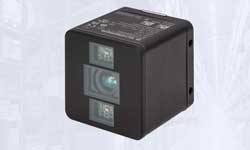 3D Camera | Industrial image processing
3D Camera | Industrial image processing
The CSD series adds affordable transmitters, indicators and controllers to the previous portfolio of electronic weighing systems: The CSD 892 is a compact weighing transmitter that offers direct readability of the data thanks to the integrated display and can be operated using four buttons on the front. The CSD 903 weighing indicator ensures improved readability thanks to its configurable, spacious display. Eight buttons ensure easy operation, and an application for one-component filling is included as standard.
The CSD 912 weighing controller is also suitable for extended dosing and filling applications and can handle up to 10 materials administer. The color touch display is particularly robust and gives the user a quick overview of the processes by displaying them as curves. The included software application Ezcts allows easy configuration. Existing settings can also be saved with it and transferred to other devices. In the CSD 918 version, the weighing controller can also measure constant amounts of inflow and outflow by connecting the valve with a combination of servo amplifier and Servomotor controls.
Basics of weighing technology
What is a load cell and what types are there?
Load cells are used to set up weighing devices such as industrial scales and checkweighers and are a special form of force transducers or force sensors. A load cell is used For determining mass: The weight exerted by the item to be weighed is converted into an electrical signal by the load cell. This makes load cells the most important components of an electronic scale. One of the most widespread technologies is based on the strain gauge technology: An analog load cell consists of a measuring element (so-called spring body) made of steel or aluminum, on which a strain gauge (Wheatstone bridge) is attached. A load cell is integrated into every electronic scale, which ensures that a weight can be measured.
Here is an overview of the most common load cell types in the industry:
- Strain gauges-Load cells are the most commonly used load cells. They are based on strain gauges (strain gauges) that change their electrical properties when they are deformed.
- capacitive Load cells measure weight through changes in capacity. They are less susceptible to temperature fluctuations than strain gauge load cells.
- hydraulic Load cells use a liquid-filled system. When the load cell is loaded, the pressure in the liquid increases, and this pressure is measured to determine the weight.
- Pneumatic Load cells work similarly to hydraulic cells, but use air or gas instead of liquid.
- Piezoelectric Load cells are based on the piezoelectric effect, in which certain materials generate an electrical voltage when subjected to mechanical stress. They are particularly useful for rapid load changes and dynamic measurements.
- Vibrations-Load cells (tuning fork) are based on the change in the resonant frequency of a vibrating fork caused by the weight applied to it.
- Optical Load cells use light to measure weight or deformation. Changes in light intensity or phase can be used to measure weight.
- Magnetostrictive Load cells are based on the magnetostrictive effect, where the dimensions of a material change in the presence of a magnetic field.

Angela Struck is editor-in-chief of the development scout and freelance journalist as well as managing director of Presse Service Büro GbR in Ried.
